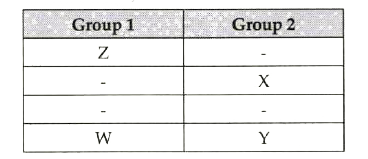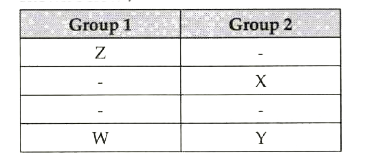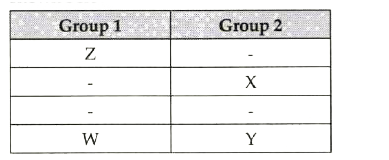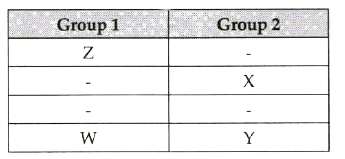Complete Solutions to TOPIC 1 Modern Periodic Table and its Periodicity (5 Marks Questions ) of chapter THE PERIODIC TABLE of Class 9 book with complete answers and questions
| Class 9 | CHEMISTRY |
| Chapter | THE PERIODIC TABLE |
| OSWAL | TOPIC 1 Modern Periodic Table and its Periodicity (5 Marks Questions ) |
| Number Of Questions | 44 |
| Academic Year | 2023-24 |
Lithium , sodium and potassium elements were put in one group on the basis of their similar properties. What are those similar properties ?
View SolutionThe elements calcium, strontium and barium were put in one group or family on the basis of their similar properties . Which were those similar properties ?
View SolutionState any two points of Mendeleev.s basis for classification of elements ?
View SolutionMendeleev's contributions to the concept of periodic table laid the foundation for the Modern Periodic Table. Justify your answer giving three points.
View SolutionThis question refers to elements of the periodic table with atomic numbers from 3 to 18. In the table below, some elements are shown by letters, even though the letters are not the usual symbols of the elements.

Which of these is a noble gas
View SolutionThis question refers to elements of the periodic table with atomic numbers from 3 to 18. In the table below, some elements are shown by letters, even though the letters are not the usual symbols of the elements.

Which of these is a halogen
View SolutionThis question refers to elements of the periodic table with atomic numbers from 3 to 18. In the table below, some elements are shown by letters, even though the letters are not the usual symbols of the elements.

Which of these is an alkali metal
View SolutionThis question refers to elements of the periodic table with atomic numbers from 3 to 18. In the table below, some elements are shown by letters, even though the letters are not the usual symbols of the elements.

Which of these is an element with valency 4.
View SolutionThis question refers to elements of the periodic table with atomic numbers from 3 to 18. In the table below, some elements are shown by letters, even though the letters are not the usual symbols of the elements.

If A combines with F, what would be the formula of the resulting compound ?
View SolutionThis question refers to elements of the periodic table with atomic numbers from 3 to 18. In the table below, some elements are shown by letters, even though the letters are not the usual symbols of the elements.

What is the electronic configuration of G?
View SolutionHelium is an unreactive gas and neon has very poor reactivity. What do these elements have in common?
View SolutionThe position of elements A,B,C,D and E in the periodic table are shown below :

State which are metals, non-metals and noble gas in this table.
View SolutionThe position of elements A,B,C,D and E in the periodic table are shown below :

State which is the most reactive (i) metal (ii) non metal .
View SolutionThe position of elements A,B,C,D and E in the periodic table are shown below :

Which type of ion will be formed by element A, B and C.
View SolutionThe position of elements A,B,C,D and E in the periodic table are shown below :

Which is larger in size (i) D or E (ii) B or C.
View SolutionWrite electronic configuration of element `underset(17)overset(35)""T`.
What is the group number of T?
View SolutionWrite electronic configuration of element `underset(17)overset(35)""T`.
What is the period number of T ?
View SolutionWrite electronic configuration of element `underset(17)overset(35)""T`.
How many valence electrons are there in an atom of T?
View SolutionWrite electronic configuration of element `underset(17)overset(35)""T`.
What is the valency of T ?
View SolutionMention the part of group where the elements show: Highest metallic character
View SolutionMention the part of group where the elements show: Big atomic size
View SolutionHow valency of elements changes : Along the period from left to right
View SolutionHow valency of elements changes : Down the group from top the bottom
View SolutionName the metalloid present in second period
View SolutionFor elements `""_19^39X`
Write electronic configuration
View SolutionFor elements `""_19^39X`
What is the group number
View SolutionFor elements `""_19^39X`
What is the period number
View SolutionFor elements `""_19^39X`
Number of valence electrons
View SolutionFor elements `""_19^39X`
Valency of X
View SolutionAn elements P has atomic no. 13.
Write its electronic configuration
View SolutionAn elements P has atomic no. 13.
State the group to which it belongs.
View SolutionAn elements P has atomic no. 13.
Elements P is metal or non-metal ?
View SolutionAn elements P has atomic no. 13.
Write the formula of its oxide
View SolutionName the scientist who proposed modern periodic law
View SolutionName first element of period 7
View SolutionAs we move down the group, the atomic size increases or decreases ?
View SolutionWhat is the common feature of the electronic configurations of the elements in group 17[VIIA]
View SolutionProperties of eka silicon resembles with which element ?
View SolutionBeryllium exhibits diagonal relationship with .................. (magnesium / aluminium).
View SolutionElements W, X, Y, Z in the periodic table are shown below:

State whether Z is metal or non-metal
View SolutionElements W, X, Y, Z in the periodic table are shown below:

State whether W is smaller or larger than Z in size
View SolutionElements W, X, Y, Z in the periodic table are shown below:

State whether Y is smaller or larger than W
View SolutionElements W, X, Y, Z in the periodic table are shown below:

Identify what type of anion or cation will be formed by Z and X
View SolutionElements W, X, Y, Z in the periodic table are shown below:

If Z is the third element of first group, identify the element and what would be the colour imparted by Z during the flame test.
View Solution
TOPIC 1 Modern Periodic Table and its Periodicity (5 Marks Questions ) questions and complete solutions for chapter THE PERIODIC TABLE of ICSE of Class 9
All Exercises from OSWAL Class 9 CHEMISTRY THE PERIODIC TABLE
- EXERCISE 5(B)
- EXERCISE 5(C)
- TOPIC 1 Modern Periodic Table and its Periodicity (1 Mark Questions )
- TOPIC 1 Modern Periodic Table and its Periodicity (2 Marks Questions )
- TOPIC 1 Modern Periodic Table and its Periodicity (3 Marks Questions )
- TOPIC 1 Modern Periodic Table and its Periodicity (5 Marks Questions )
- TOPIC 2 Studying Individual Groups (1 Mark Questions)
- TOPIC 2 Studying Individual Groups (2 Marks Questions)
- TOPIC 2 Studying Individual Groups (3 Marks Questions)
- TOPIC 2 Studying Individual Groups (5 Marks Questions)